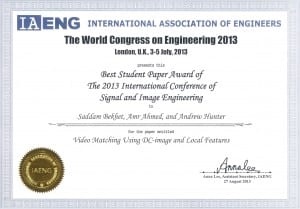The paper “Compact Signature-based Compressed Video Matching Using Dominant Colour Profiles (DCP)” has been accepted in the ICPR 2014 conference http://www.icpr2014.org/, and will be presented in August 2014, Stockholm, Sweden.
Abstract— This paper presents a technique for efficient and generic matching of compressed video shots, through compact signatures extracted directly without decompression. The compact signature is based on the Dominant Colour Profile (DCP); a sequence of dominant colours extracted and arranged as a sequence of spikes, in analogy to the human retinal representation of a scene. The proposed signature represents a given video shot with ~490 integer values, facilitating for real-time processing to retrieve a maximum set of matching videos. The technique is able to work directly on MPEG compressed videos, without full decompression, as it is utilizing the DC-image as a base for extracting colour features. The DC-image has a highly reduced size, while retaining most of visual aspects, and provides high performance compared to the full I-frame. The experiments and results on various standard datasets show the promising performance, both the accuracy and the efficient computation complexity, of the proposed technique.
Congratulations and well done for Saddam.
Analysis and experimentation results of using DC-image, and comparisons with full image (I-Frame), can be found in Video matching using DC-image and local features (http://eprints.lincoln.ac.uk/12680/)

